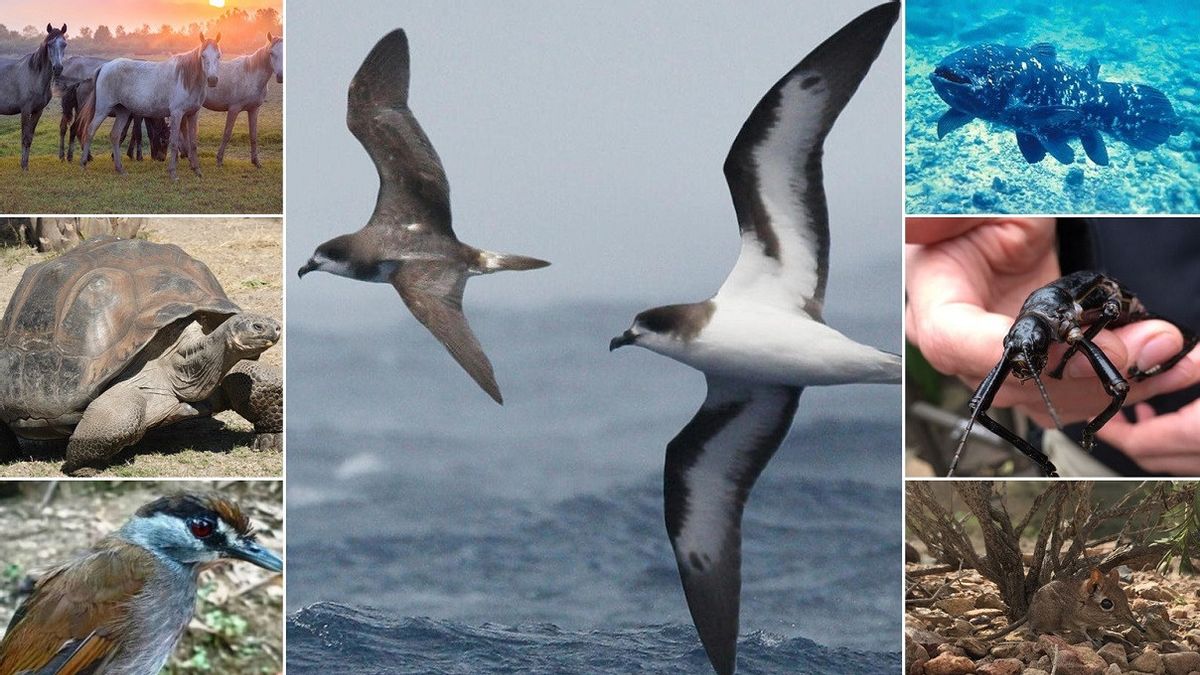JAKARTA - The World Wildlife Fund (WWF) estimates that on average the world has experienced a 60 percent decline in the population size of mammals, birds, fish and amphibians due to human activities.
We all know about the wild success of the panda's transition from near extinction to vice versa, but under-publicized conservation projects can come in the most bizarre ways and achieve a lot.
There are hundreds of examples of other species emerging from the other side of their battle with extinction. Either it takes decades or millions of years.
According to Euronews, here are some of the remarkable conservation successes and unexpected resurgences of species once thought to be extinct.
Somali elephant rat
Resembling a mouse but having a trunk like an elephant, this compact pangolin-like creature is believed to have gone extinct in the 1960s due to a lack of data. Global Wildlife Conservation (GWC) has even listed it as the 25 most wanted species after no sightings.
The researchers decided to investigate further nearly 50 years after reports of sightings in Djibouti, a country on the edge of Africa. They are confused by this kaabr, because their namesake is the only country believed to have been inhabited before the extinction.
After going through a series of searches, researchers managed to find these 12 animals living happily without any direct threat to their well-being, and hope to maintain this existence. Thankfully it has since been removed from the list and may even have carried its tiny feet across the Horn to Ethiopia.
Fernandina's giant tortoise
This one took more than a century, but was certainly worth the wait. Turtle conservationists were overjoyed to find this reptile droppings in Galápagos National Park after there had been no sign of life since 1906. The tortoise responsible is a female who is known to have roamed the island around the clock. It is surprising how this is possible given the massive lava flows on the Galápagos Islands.
Age has no effect on mating prospects, as turtles can live until they are 200 years old. Park rangers throughout the project are planning further expeditions to find him a friend.
The director of the Giant Tortoise Recovery Initiative (GTRI) of the Galápagos Conservancy called it the "most important achievement" of his life.
Lord howestick insect
This huge 'tree lobster' is thought to have been significantly impacted by a shipwreck on Lord Howe Island in Australia more than 100 years ago.
A number of Lord Howe's stick insects staggered downwards until they were finally classified as extinct in the 1980s. They were found thriving in the trees surrounding the Balls Pyramid, an island formed from volcanic remains, decades later.
In fact, this regrouping of certain species is not without its challenges. Scientists think the differences between these stick-like creatures are too difficult to distinguish from similar species.
This story has a happy ending thanks to the captive program zoo and genome sequencing of old museum remains. The Australian government now plans to reintroduce them to the island.

The rediscovery of the coelacanth is considered one of the most important animal rediscoveries of the 20th century. Why? Because they predate the dinosaurs, that's why. Prior to its rediscovery, the only known existence of the coelacanth through the fossil record was more than 65 million years old, when it was thought to have become extinct.
None of this would have been possible without the insights of self-taught zoologist Marjorie Courtenay-Latimer. South African museum workers are often brought in to identify the fishermen's odd finds and enlist the help of Professor James Leonard Brierley Smith to do so. They conveyed the news of his whereabouts via telegram.
Much of their behavior remains a mystery to conservationists, but we do know that they live a serene existence on the seabed and recent surveys estimate the population at 230-650 fish. And, this fish is also known to be found in Indonesian waters.
Caspian Horse
There was a time when Americans thought the Caspian Horse, the preferred beginner breed for novice equestrians, was a historical footnote. They were rediscovered in the mountains of Iran by researcher Louise Firouz while she was looking for horses to accompany her new equestrian center for children.
He realized that they would use the land to take refuge from carrying the chariots of the rich Persians and Egyptians. Make it his mission to create breeding flocks where they can breed. They were even able to live through his brief imprisonment during the Iranian revolution. Luckily it worked and now there are over a thousand Caspian Horses around the world.
Bermuda petrelDating back to the 15th century it is said, more than a million Bermuda Petrels call the island their home. Given that the human population on the island currently stands at 60,000 or more, their existence must be sufficient.
After a long period of extermination of land mammals, their extinction seemed certain to the point that they were given the name "lazarus species" - a bird so distinct, any increase in population would seem like a return from the dead.
This comeback became a reality in the 1950s by chance and has since been facilitated by the fact that these birds (adorably) mate for life.
A settlement project is underway on Nonsuch Island after the first batch of birds has been printed. Tourists can see it live on boating tours and amazing live cameras that can be streamed online.
Black eyebrow tinker
The black-brow babbler or in Indonesia is called the Kalimantan monkey, was accidentally discovered by two bird watchers roaming the rainforests of Borneo, after long thought to be extinct.
After some speculation in the global ornithological community, they were able to unveil an incredible discovery last October. Time away from public life is the longest "longest period" of any Asian animal and one has no idea what has happened in 170 years. Researchers now think they may be hiding in plain sight from people who don't know how to find them.
"The sensational discovery confirms that the Black-browed Babbler originated in southeastern Borneo, ending a century of confusion about its origins," said Panji Gusti Akbar of the Indonesian bird conservation group, Birdpacker. This has created an invaluable framework for making their forest population grow.
The English, Chinese, Japanese, Arabic, and French versions are automatically generated by the AI. So there may still be inaccuracies in translating, please always see Indonesian as our main language. (system supported by DigitalSiber.id)













